HERE'S TO HYGGE: KEEPING COSY
STROKE: THE SIGNS AND SYMPTOMS RELIEVING SINUSITIS
RISE OF THE RUN CLUB: THE FUN WAY TO KEEP FIT

HERE'S TO HYGGE: KEEPING COSY
STROKE: THE SIGNS AND SYMPTOMS RELIEVING SINUSITIS
RISE OF THE RUN CLUB: THE FUN WAY TO KEEP FIT
Removes+ 99.9% of odour-causing bacteria**
+When used as directed.
**In laboratory tests. Kiesow, A. et al. (2016) J. Prosthet. Dent. 115(2) 189-198.
Financial Sponsor: Haleon. Trade marks owned or licensed by Haleon. © 2024 Haleon or licensor. PM-AU-POLD-24-00061. AC-005704.


As the Winter chill settles in, it's time to embrace the Danish concept of hygge—keeping cosy and content despite the frosty weather. In this issue, we explore the art of hygge (page 13) and how it can bring warmth and comfort to your life. Additionally, we shed light on the signs and symptoms of stroke, a condition that demands swift recognition and action. To learn how to identify the warning signs and take proactive steps towards stroke

prevention and intervention, head to page 28. For those battling sinusitis, on page 8 we offer relief through expert tips and remedies, ensuring that seasonal discomfort doesn't hinder your Winter joy. And if you're looking to stay active in the cold months, perhaps it's time to join a run club—a fun and social way to keep fit while embracing the cooler season (page 31). Here's to a season of cosiness, wellness, and community.



a Pharmacist
IN ADDITION TO DISCUSSING YOUR HEALTH NEEDS WITH YOUR GP, PHARMACIST AND PHARMACY TEAM, MEDICINE LABELS ARE AN IMPORTANT ASPECT IN HELPING YOU MAKE AN INFORMED DECISION WHEN BUYING PRESCRIPTION AND OVER-THE-COUNTER MEDICINES, SUNSCREENS, OR VITAMIN SUPPLEMENTS. READ ON TO FIND OUT MORE ABOUT HOW ACTIVE INGREDIENTS WORK

“The active ingredient is the ingredient of the medicine that allows the medicine to have an effect in the body.”1 They are also commonly known as active pharmaceutical ingredients (API).
Some examples of active ingredients are:
• Paracetamol in pain relief medicines
• Atorvastatin in cholesterol-lowering medicines
• Ascorbic acid (vitamin C) in some multivitamins.2
In addition to active ingredients, medicines consist of Inactive ingredients (also known as excipients) which are all the other non-active ingredients used in a medicine. These components all work together to produce the desired outcome of the medicine.
Other examples of inactive ingredients are:
• Preservatives, which help prevent growth of microorganisms inside the medicines.
• Flavours to give medicines a pleasant taste and increasing medicine acceptance or compliance.
• Colours chosen and used by the manufacturer with a goal of easing drug identification and reducing medication errors.
• Fillers that help ingredients in a tablet stick together.2
For most patients, the types of inactive ingredients used are not significant. However, some people may be sensitive to some inactive ingredients that are commonly used in the production of medicines.
Some of these inactive ingredients include lactose, fructose, gluten, or starch, which may trigger an allergic reaction for those who are sensitive to these constituents.3
We recommend consulting your GP or Blooms The Chemist Pharmacist for advice when changing or substituting the brands of your medications.
APIs are usually made from a very complex chemical process which involves various stages.4 For example, atenolol, which is a very common medication used for several cardiovascular diseases, goes through a range of chemical measures before it can be considered an API. They are usually made from chemical compounds that are in the process of becoming an API from raw materials.
It is important that we make sure that APIs in medications are safe to use. APIs, regardless of any local standards where they are manufactured, must meet the safety and quality criteria of the
country where the medicine is sold and consumed. Medicines sold in Australia must meet the strict safety, quality, and regulatory standard of the Therapeutic Goods Administration (TGA).
The TGA’s manufacturing quality branch is responsible for the assessment, inspection, and licensing of medicine manufacturers supplied to or exported from Australia.5 The regulatory process of the TGA is designed to ensure the maintenance of appropriate standards of quality, safety, and efficacy of medications.6 This means that all medications available in Australia have undergone a series of regulatory processes to ensure its safety, efficacy and quality profile, at a standard that is comparable to other countries.
If you’d like to find out more about your medications or active ingredients, have a chat with your local Blooms The Chemist Pharmacist.

1TGA labelling and packing review: https://www.tga.gov.au/book/prominenceactive-ingredients-medicine-labels
2What ingredients are in my medicine? https://www.tga.gov.au/what-ingredientsare-my-medicine
3Inactive” ingredients may not be study finds: https://news.mit.edu/2019/inactiveingredients-reactions-study-0313
4Understanding active pharmaceutical ingredients: https://www.sciencedaily.com/ releases/2014/06/140605093305.htm
5Update to Manufacturing Principles for medicines, APIs & sunscreens: https://www. tga.gov.au/update-manufacturing-principles-medicines-apis-sunscreens
6Prescription medicines registration process: https://www.tga.gov.au/prescriptionmedicines-registration-process
Blackmores Concentrated Curcumin Range with anti-inflammatory action to help you stay active.
NEW
Good health changes everything


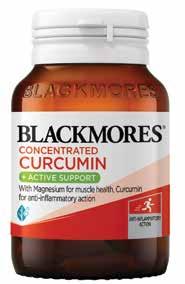

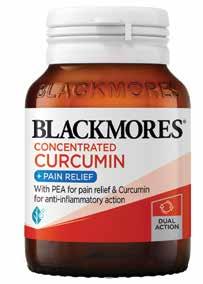

Always read the label and follow the directions for use.

How long have you been a Pharmacist with the Blooms The Chemist network?
I've been a Pharmacist for 13 years, and I've been part of the Blooms The Chemist network for almost my entire career.
What made you want to be a Pharmacist?

I love the mix of health and business. I was inspired when I was younger by a local Pharmacist in my hometown, called Tony. I did a placement (an unpaid internship) at his store when I was 16 and I loved the trust and rapport he built with customers and seeing how his knowledge helped them.
What is the most important thing you've learned as a Pharmacist?
Attention to detail. It’s the little things that people remember whether they’re coming in for the first or the hundredth time.
How do you relax or spend your free time?
I like spending time with my friends whether it’s outdoors, visiting restaurants or bars, or just having a coffee. And, I love spending time with my dogs.
What's the best thing about your community?
I love the diversity of the community I work in, as well as the beauty of the nature around us.
How does your pharmacy give back to your local community?
Our pharmacy gives back through charities such as Make-A-Wish Australia and the Gidget Foundation. My pharmacies are involved in local charities and organisations they partner with, such as Care Flight, Seniors groups, and Parkinson's Foundation. We’ve attended Career days for schools and local health exhibitions, and
hope to get even more involved in community initiatives this year!
We also provide free medication packing and delivery, which are valuable and much-appreciated services to the community.
How do you best support your team and customers?
The first step is connecting with people to build rapport and a relationship no matter who they are. Then it comes down to listening and being there to help. But also throwing in some fun and laughs!
What are five things you couldn't live without?
My friends, family, dogs, hair straightener, and dry shampoo.
Do you have a quote you live by?
“Life is happening for me and not to me.”
What’s your best health tip?
There isn't a condition I could think of that isn't helped by good hydration, diet, sleep and exercise - these are often the best medicines.
If you could give a shout out to one of your regular customers, who would it be and why?
A big shout out to Kelvin - he is truly the kindest person I have met. He is always so grateful and positive for even the littlest of things. Every time he visits, we all want to be the one serving him - he makes everyone feel so happy and appreciated.
What are you excited about for the future of your store?
I’m excited to expand our home delivery and packing services to reach a wider part of the community. I also love seeing the growth of my team as we train and learn together.

SINUSITIS IS A FAIRLY COMMON CONDITION WITH A RANGE OF CAUSES. ALTHOUGH RARELY SERIOUS, THE SYMPTOMS CAN BE UNPLEASANT. LET’S TAKE A LOOK AT THE HOW THE SINUSES WORK, SINUSITIS SYMPTOMS, AND HOW TO MANAGE THEM.
The sinuses are four areas of air-filled cavities in some of the bones in our faces and foreheads – above the eyes, and on either side of the nose, and on both the left and right sides of our heads. These cavities help to produce clear mucus in the nose, which moistens the air we inhale and acts as a barrier against dirt and infection.1
This is the most common sinus problem, which occurs when the lining of your sinuses becomes inflamed. The sinuses get blocked up and fill with fluid, which is a breeding ground for bacteria – which cause pains and other symptoms.
A sinusitis episode is classed as ‘acute’ if it lasts for less than four weeks. It is ‘chronic’ if it lasts 12 weeks or more, or if it keeps coming back.2 Acute episodes are usually caused by a virus, such as the common cold, while chronic episodes are usually caused by bacteria, a structural problem in the nose or face, or an injury.
There are three key sources of a sinus infection:
• Viral: The common cold is the most typical cause of sinusitis
• Bacterial: Sinusitis can be caused by a bacterium such as Streptococcus pneumonia or Haemophilus influenzae
• Fungal: Sinusitis can develop if you breathe in a fungus such as mould or yeast.
Sinusitis risk factors
You are more at risk of developing a sinus infection if you have, or have had:
• A respiratory infection: Sinusitis is quite common after a blocked nose due to a cold or the flu.
• Allergic rhinitis: This usually refers to hay fever, but can also be triggered by dust, mould, or animal fur. It is linked to sinusitis because rhinitis makes your nose stuffy and blocked. The sensitive linings of your nose then react, and become inflamed and swollen, which in turn blocks your sinuses.
• Nasal polyps: These are little growths of excess tissue which are rarely serious but can cause problems and discomfort. Polyps can block your normal mucus flow, causing it to build up and get infected. Your doctor will usually prescribe medication; however, sometimes surgery is needed. This is usually a straightforward day case. Unfortunately, polyps can come back.
• An inherited condition: Some people are born with structural differences in their nose or sinuses, which can cause problems.3 For example, you might simply have very narrow nasal passages, or just one narrow side caused by a deviated septum (when the bone and cartilage structure in the middle of your nose is crooked). This can mean that your sinuses don’t drain properly, which can lead to sinusitis.
• An injury: If you’ve had a broken nose, jaw or cheekbone, your nasal passages can get blocked, which increases your risk of sinusitis. As a result of tooth extractions, it’s also possible for a sinus to perforate, which means that a hole can develop in the delicate membrane which separates your sinuses from the rest of your head. This can lead to infections and other complications.
• A discharge from your nose – which can be sticky, odd-smelling, and a bright neon yellow
• A stuffy nose
• Bad breath
• Loss of your sense of taste and smell
• A fever
• A sore throat and even a cough
• Nausea
• Feeling generally unwell.
It’s important to think about the treatment of both the cause and symptoms of sinusitis, because they aren’t the same thing.
Since most cases of sinusitis are caused by a virus, antibiotics won’t help. In such cases, it will usually clear up all by itself after a week or so. Therefore, for the first 7-10 days, it’s best just to try and treat the symptoms by yourself (see the section below).
If you still have symptoms after 10 days, you’ll need to see your Pharmacist or GP to find out the cause. If the cause was bacterial, you’ll need a course of antibiotics. A doctor may also identify whether you have a structural problem, such as a deviated septum.
Some people need surgery. This might be to drain a badly blocked sinus, or to widen your nasal passage if it’s too narrow or deviated, putting you at risk of chronic sinusitis.
To treat the symptoms, you could try:
• Taking a non-steroidal anti-inflammatory painkiller like ibuprofen
• Drinking plenty of water to thin out the mucus in your sinuses
• Inhaling steam a few times a day (for example, linger under a hot running shower, or sit over a bowl of hot water with a towel draped across your head and the bowl to contain the steam)
• Pressing a warm, moist cloth to your face several times a day
• Using a saline spray in your nose several times a day. It’s important to use the right nasal spray, because a decongestant could do more harm than good. Your local Blooms The Chemist Pharmacist will be happy to advise you on which products work for you.
You might want to try to prevent sinusitis, especially if you’ve had it already or you’re at risk of chronic and repeated episodes. Our top tips:
• Drink plenty of water
• Inhale steam regularly – making sure it’s not too hot
• If your nose tends to get dry, try using a humidifier at home or at work
• Sleep with your head elevated, using extra pillows or a foam wedge
• Avoid antihistamines and decongestants as much as possible.
The symptoms may include:
• Pain and tenderness in your forehead and/or your cheeks (which can be startling if you bend forward suddenly with your head down), behind your eyes, and even in your jaw, teeth and ear
1Sinusitis: https://www.betterhealth.vic.gov.au/health/conditionsandtreatments/sinusitis
2Chronic sinusitis: https://www.mayoclinic.org/diseases-conditions/chronic-sinusitis/ symptoms-causes/syc-20351661
3Sinusitis and its association with deviated nasal septum at a tertiary hospital: https:// www.ncbi.nlm.nih.gov/pmc/articles/PMC9519609/

If a bloated belly is your post-meal norm... If your dinner feels like a rock in your stomach... and you can’t stop breaking wind... CARUSO’S BLOAT EZE® CAN HELP!
No one likes feeling bloated. That full, uncomfortable feeling in your belly can have you feeling like you gained 5 kilos overnight...
And then there’s the digestive spasms, stomach upsets, nausea and worst of all... the dreaded wind that makes you feel like you’ve turned into a human wind turbine! Don’t let bloating and indigestion make you dread your next meal!
Caruso’s BLOAT EZE® is a unique debloating and digestive support formula which combines traditionally used herbs with digestive enzymes.
It contains Peppermint and Ginger which are traditionally used in Western Herbal Medicine to relieve the symptoms of indigestion, reduce uncomfortable abdominal bloating and help reduce the occurrence of abdominal bloating, and relieve wind. As an added benefit, Ginger is traditionally used in Western Herbal Medicine to relieve digestive spasms, nausea and the symptoms of stomach upsets.
The formula also includes Sweet orange which is traditionally used in Western Herbal Medicine as a bitter tonic and to stimulate the secretion of digestive juices.
Caruso’s BLOAT EZE® contains four digestive enzymes to maintain healthy digestion
Digestive enzymes break food down so that nutrients can be absorbed into your bloodstream. They support your body’s own healthy digestive processes and maintain healthy digestion.

BLOAT EZE® contains tilactase, lipase, protease and amylase, which help your body digest lactose, fats, proteins and carbohydrates.
Say goodbye to uncomfortable belly bloat and embarrassing wind
If you’d like relief from uncomfortable abdominal bloating and embarrassing wind try Caruso’s BLOAT EZE® today!
Caruso’s BLOAT EZE® is made in Australia and comes with a 100% Money Back Guarantee*
At Caruso’s we always source quality ingredients to go into our products and we only develop formulas that we truly believe will help support our fellow Australians. That’s why we stand behind all of our products with a 100% Money Back Guarantee. See our website for more details.
For more information please call our Customer Service Representatives on 1300 304 480 or visit carusoshealth.com.au
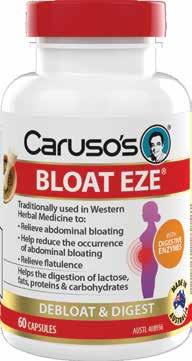

Always read the label and follow the directions for use.
*See Caruso’s Natural Health website for terms and conditions of 100% Money Back Guarantee.

IRON IS A VITAL NUTRIENT WHICH HELPS TO KEEP US HEALTHY. MANY OF US MIGHT ASSUME THAT NAGGING TIREDNESS COULD BE DOWN TO LOW IRON, BUT IT’S IMPORTANT NOT TO SELF-DIAGNOSE AND SELF-TREAT. HERE, WE LOOK AT THE CAUSES, SYMPTOMS AND TREATMENTS OF IRON IMBALANCES.
Our bodies need quite a few minerals to keep us healthy, and one of the main ones is iron. We should be able to get all the iron we need from a healthy diet, but sometimes we don’t get enough – or, even if we do, the body may not be able to absorb it properly.
Low iron is the most common nutritional deficiency in the world, affecting around 3.5 billion people. About a third of them have iron deficiency anaemia, and the remaining two-thirds have iron deficiency without anaemia.1
Around 5% of Australians have iron deficiency anaemia.2 It can develop if you simply don’t have enough red blood cells to carry the oxygen around your body.
Our bodies need iron for several reasons, including a healthy immune system and thyroid function, but one of the most important is for energy. We don’t just need energy for being active: it’s needed for breathing and keeping our hearts pumping, for example.
Iron helps our bodies make two proteins needed for energy. The first is haemoglobin, which lives in our red blood cells and carries oxygen from our lungs all around our bodies. The second is myoglobin, which stores that oxygen in our muscle cells and releases it when a muscle needs to work.
Your iron levels might be low if you:
• Feel tired all the time and have no energy
• Are often a bit breathless
• Feel dizzy
• Sense your heart racing or fluttering
• Have pale skin
• Have cold hands and feet.
Low iron levels might be caused by:
• Loss of blood: This can happen after an injury or operation, or because of having a period
• A gastrointestinal condition: Such as stomach ulcers, haemorrhoids, gallstones, or inflammatory bowel disease (IBD)
• Kidney disease: The kidneys help your body make red blood cells. When you have kidney disease, your red blood cell count can drop, and you may develop anaemia.
• Pregnancy: In pregnancy, the body makes more blood so the amount of iron needed also increases
• Poor nutrition: You won’t get enough iron through your diet if you’re not eating enough iron-rich foods
• Malabsorption: Even if you’re taking in enough iron, your body may not be able to absorb it and that means you won’t get the benefits. This can be caused by conditions like coeliac disease, Crohn’s disease, intestinal parasites such as tapeworms, and liver disease.
Unless you have anaemia, you should be able to manage your iron levels by eating more iron-rich foods. These include eggs, fish, leafy greens (such as spinach, silverbeet, and kale), beans and lentils, oats, red meat, and iron-fortified foods.3
If you need extra help, or you are found to have iron deficiency anaemia, you may require an iron supplement. This can be in tablet, capsule, or liquid form, and you’ll be advised how much to take and how often. You might also need to take vitamin C, which helps the body to absorb the iron. However, you should ensure you talk to your healthcare practitioner before you begin taking iron supplements.
People who really struggle with low iron may need a blood transfusion. This is a simple and safe procedure; you sit or lie down and a needle is inserted into your vein. It can take a few hours, and you can usually go home afterwards.
If you think your iron levels might need checking, you can get an initial screening at your local Blooms The Chemist - it only takes a minute, and could put you on the path to better energy levels and overall health.
1Iron deficiency without anaemia: a diagnosis that matters: https://www.ncbi.nlm.nih. gov/pmc/articles/PMC8002799
2Iron and iron deficiency: https://www.betterhealth.vic.gov.au/health/ conditionsandtreatments/iron
3Dietary iron makes healthy bodies: https://dietitiansaustralia.org.au/health-advice/ dietary-iron-makes-healthy-bodies


# OR YOUR

#Terms & conditions apply. For full T&Cs visit www.cetaphilmoneyback.com.au Purchase Period: 01am (AEST) on 01/06/2024 to 11.59pm (AEST) on 31/08/2024. Claim period: 01am (AEST) on 04/06/2024 to 11.59pm (AEST) on 07/09/2024. AU residents only aged 18 years and over. Retain receipt as proof of purchase. Each household can make a maximum of 1 claim and each claim can only be for one Cetaphil product. Maximum refund is $35. *Cetaphil HCP Tracking Research, Galderma, 2021. AU-CET-2400019.
HYGGE CAPTURED THE WORLD’S FASCINATION IN 2016, BECOMING THE LIFESTYLE TREND THAT DEFINED THE YEAR AND ONE OF 2016’S HOTTEST BUZZWORDS. THE CRAZE IS STILL CONVERTING FOLLOWERS, WITH PEOPLE SCRAMBLING TO LOAD UP ON COSY KNITS AND SCENTED CANDLES TO EXPERIENCE THE POPULAR DANISH MOVEMENT.
The word hygge, pronounced “hoo-ga”, cannot be directly translated, but focuses on embracing the little things and cultivating a cosy life of contentment and comfort. Originally derived from the Norwegian word for ‘wellbeing’, hygge is a way of life designed to help you create a life you truly love.
Hygge isn’t expensive or hard to incorporate into your life. All you need are a couple of candles, a cup of tea, and your favourite pyjamas. In fact, candles should be considered a prerequisite for the trend, as Denmark is known to burn more candles than anywhere else in the world. Other ways to embrace hygge include taking a long walk, inviting family and friends over for a meal, or redecorating your home for a more minimalist and cosier feel. But regardless of how you choose to include a little bit of hygge into your life, it all comes down to doing whatever makes you happy and investing in your own self-care to live a life of contentment.
What better way to hop on the hygge bandwagon than by putting an Aussie spin on the movement? Make the most of the cooler seasons by hosting an indoor picnic with family and friends, head outdoors for a mind-clearing walk, or take a calming bath with essential oils. In the Summer, head down to your local beach for a relaxing swim or relax in the shade with a good book.
There’s a reason the Nordic nations continually top the World Happiness Report. Keep an eye out for the following upcoming Scandinavian trends; you’ll want to experience these first-hand before they become mainstream!
Friluftsliv, pronounced ‘free-loofts-liv’, hails from Norway and translates to ‘free air life’, encouraging us to explore and connect with the environment.
Lagom, pronounced ‘lar-gohm’, is a Swedish term that means ‘not too little, not too much’ or ‘just right,’ allowing Swedes to embrace a life of balance and the pleasure of slowing down.
Sisu is a Finnish concept that describes the ability to overcome adversity and to harness our inner strength and determination. Taking on an action mindset is a major part of sisu, helping to push past our comfort zones and embrace everything that life has to offer.
1Copenhagenize: http://www.copenhagenize.com/2016/11/hygge-and-firepit-of-trans port.html

OFTEN JUGGLE MULTIPLE ROLES – CAREER PROFESSIONAL, LOVING PARTNER, CARING PARENT, AND SUPPORTIVE FRIEND. WHILE IT’S IMPRESSIVE TO BE ABLE TO BALANCE THE EXPECTATIONS OF EACH OF THESE ROLES, TRYING TO DO TOO MUCH CAN LEAD TO BURNOUT.
Burnout can affect anyone from any walk of life. It's no surprise that many women, whose list of responsibilities seems longer than ever before, experience the symptoms of burnout. Learning to recognise the signs, and preparing yourself if you think you may be at risk, could make all the difference to your physical, mental, and emotional health.
Burnout is more than just feeling tired; it’s a state of chronic physical and emotional exhaustion, often accompanied by a sense of detachment and reduced performance. Women, in particular, can be more susceptible to burnout due to societal expectations and the constant pressure to excel in every area of life.
Recognising the signs of burnout is the first step towards protecting your vitality. Common symptoms include persistent fatigue, a decline in your brain power, heightened irritability, and a diminished sense of accomplishment. Many women may dismiss these signs as a normal part of a busy life, but acknowledging them early on is crucial to prevent burnout from taking a deeper toll.
• Staying balanced: Finding the right balance is key to preventing burnout. Women often feel the need to be perfect in every aspect of their lives, but it’s essential to embrace imperfection and understand that it’s okay to prioritise self-care. Delegate tasks, set realistic goals, and learn to say no when necessary. Remember, taking care of yourself is not a luxury; it’s a necessity.
• Keeping connected: Women are seen as natural caregivers, but can often neglect their own needs in the process.1 Building a strong support system is crucial in the fight against burnout. Share your thoughts and feelings with friends, family, or colleagues, and don’t hesitate to ask for help when needed. Genuine connections can be a powerful antidote to the isolation that burnout often brings.
• Mind-body harmony: This is essential for overall wellbeing.2 Incorporate activities that bring joy and relaxation into your daily routine, whether it’s yoga, meditation, or a simple walk in nature. Nourish your body with wholesome food, prioritise regular exercise, and ensure you get adequate sleep. Small, consistent steps can make a significant difference in restoring your energy and resilience.
• Redefining success: In a world that often measures success by external achievements, it’s crucial for women to redefine success on their terms. Take the time to reflect on your values and priorities. Success isn’t just about climbing the career ladder or managing a perfect household. It’s about finding fulfilment and joy in your journey, whatever that may look like for you.
• Knowing when to seek help: If burnout persists despite your best efforts, seeking professional help is a proactive step towards recovery. Mental health professionals can provide valuable insights and coping strategies to navigate the challenges you may be facing. Remember, asking for help is a sign of strength, not weakness.
While burnout may be an all-too-common companion for many of us, it can be managed and avoided by practising self-awareness and self-compassion, building a support system, and defining what success and fulfiment looks like for you.
1Why women are more burned out than men: https://www.bbc.com/worklife/ article/20210928-why-women-are-more-burned-out-than-men
2Women continuing to face alarmingly high levels of burnout, stress in the “new normal” of work: https://www.forbes.com/sites/deloitte/2022/04/26/ womencontinuing-to-face-alarmingly-high-levels-of-burnout-stress-in-the-newnormal-ofwork/?sh=5382335a432e

*Rapid nasal symptom relief
ALWAYS READ THE LABEL AND FOLLOW THE DIRECTIONS FOR USE.
Treats moderate to severe hayfever symptoms.
References: 1. Bousquet J et al. J Allergy Clin Immunol Prac 2018; 6(5): 1726-1732. (Funded by MEDA Pharma GmbH & Co. KG). 2. Dymista® Allergy Product Information. Dymista® is a Viatris company trademark. Copyright © 2024 Viatris Inc. All rights reserved. AU-DTC-2024-00001 March 2024.
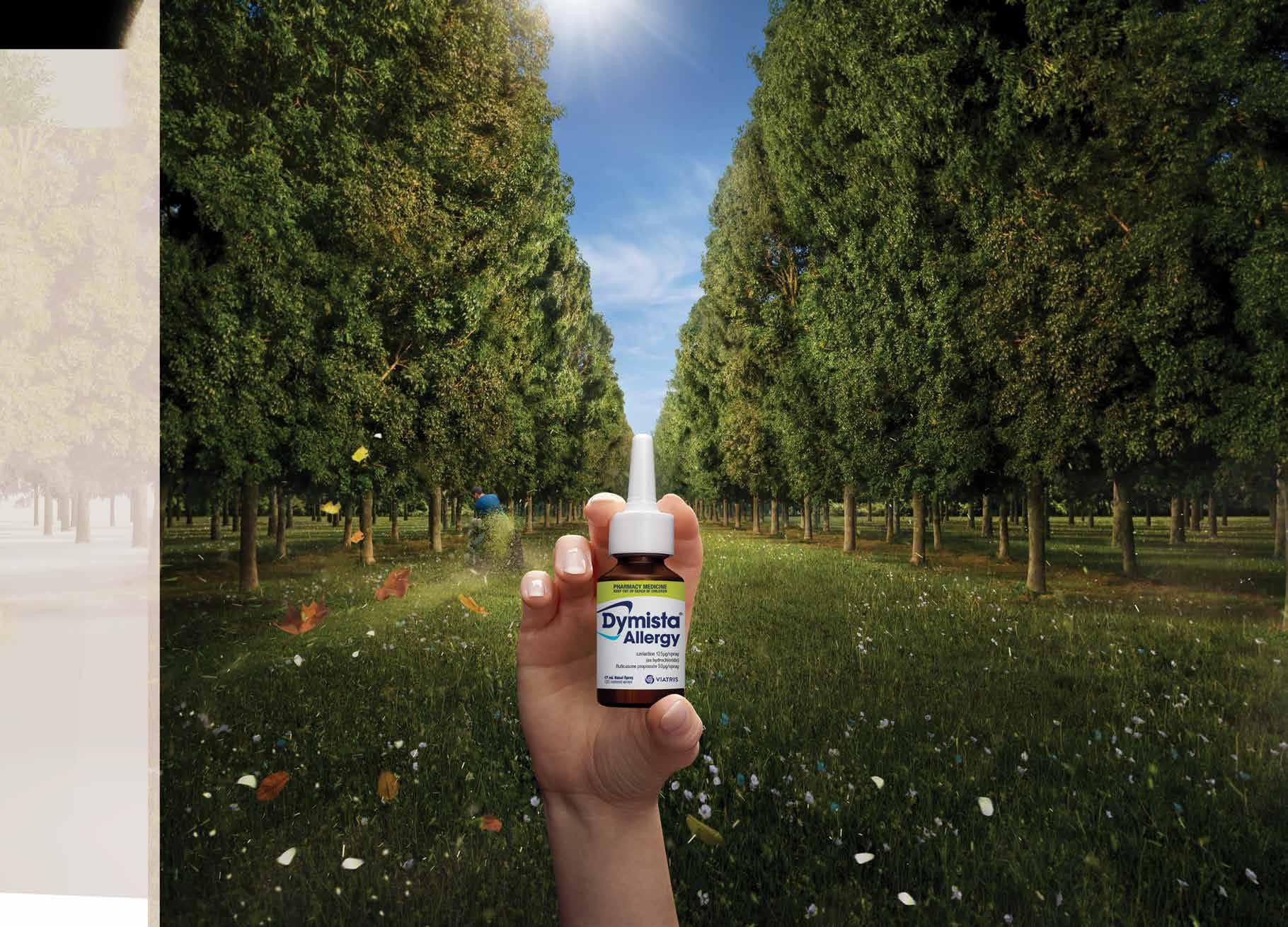


Are
MOST OF US PROBABLY DON’T GIVE A THOUGHT TO HOW WE BREATHE. BUT THE WAY WE DO IT CAN AFFECT OUR HEALTH, SO IT’S WORTH FINDING OUT WHETHER WE TEND TO BREATHE THROUGH OUR NOSES OR OUR MOUTHS.
Breathing through our noses is better for us, and it’s what nature intended – for good reason. Yet one study found that between a third and half of all adults breathe through their mouths.1 And this can create a range of potential problems and risks.
Mouth-breathing is common among people with blocked or restricted nasal passages – perhaps because of a cold or hay fever, a deviated septum, or nasal polyps (little extra clumps of tissue inside the nose).
Just 5-6% of children are mouth-breathers.2 It often starts around the age of three, when the tonsils and adenoids are growing fast and nose-breathing can be more difficult. Thumb-sucking and dummies can also be a cause.3 Picking up the habit in childhood can stick, even after the underlying reason is resolved.
• The tiny hairs in your nose (cilia) help to filter out dust, allergens and even insects
• It can boost your oxygen uptake by 10% to 20%4
• It moistens the air you breathe in, and warms it in cold weather
• It carries less risk of ‘over-breathing’ (hyperventilation).
• A dry mouth
• Bad breath, inflamed gums and tooth decay
• Irritated airways, especially in cold, dry air
• Allergies and asthma
• Sleep disorders such as snoring and sleep apnoea
• Daytime exhaustion
• Possible changes in the structure of the face (including a receding chin, misaligned jaw, and floppy lips).
Besides the other risks, young mouth-breathers can develop ‘mouth-breathing face’ or ‘long-face syndrome’ – usually a receding chin or jaw, and a narrower face.5 It can mean crowded teeth and a poor ‘bite’, where the upper and lower teeth don’t align properly.
Almost 82% of children who breathe through their mouths develop speech disorders – including lisps, stuttering.6
If you’re concerned about your own child, speak to your local healthcare professional.
It can be difficult to break the mouth-breathing habit, but it’s definitely worth trying:
• Talk to a professional: Always consult a doctor first, and talk to your dentist, to see what underlying conditions might cause your mouth-breathing and to spot any symptoms which may need dealing with.
• Clear your nasal passages: If you know you have allergies, or a cold, try using a nasal spray (your Blooms The Chemist Pharmacist will be happy to advise you) or a humidifier in your home.
• Be breathing-aware: Practise breathing in through your nose and out through your mouth. Use your diaphragm to breathe deeply, so you’re not just breathing at the top of your lungs.
• Adjust your sleeping position: Try to sleep on your side or propped up; supportive pillows may help.
• For children: Do manage allergies, infections, thumb-sucking and dummies. Braces to realign the teeth and jaw may be helpful.
• Surgery: An operation might be needed to remove nasal polyps or enlarged adenoids.
If you’re wondering whether you or a loved one might be breathing incorrectly, it’s worth getting it checked out. Regulating your breathing could resolve all kinds of problems, including feeling less tired as well as managing allergies and dental issues.
1The health benefits of nose breathing: https://www.lenus.ie/handle/10147/559021
2What’s with all the fuss about nose breathing? https://www.smh.com.au/lifestyle/ health-and-wellness/what-s-with-all-the-fuss-about-nose-breathing-20220614p5atn2.html
3What to Know About Mouth Breathing In Babies and Children: https://www.webmd. com/children/what-to-know-about-mouth-breathing-in-babies
4The health benefits of nose breathing: https://www.lenus.ie/bitstream/ handle/10147/559021/JAN15Art7.pdf
5The impact of mouth breathing on dentofacial development: https://www.ncbi.nlm. nih.gov/pmc/articles/PMC9498581
6Mouth breathing and speech disorders: https://www.ncbi.nlm.nih.gov/pmc/articles/ PMC9469305



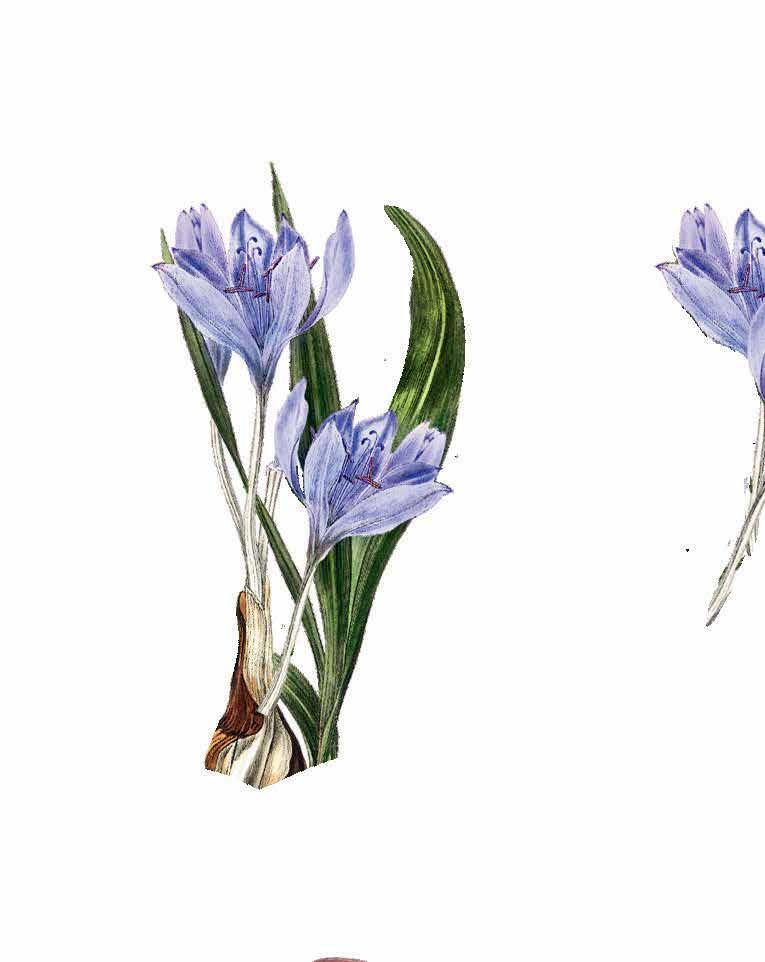

Contains saffron extract (affron ®) to support healthy mood balance, plus reishi, which is traditionally used to relieve fatigue and calm the mind in traditional Chinese medicine. Also contains nutrients that support mental function and energy levels.
Always read the label, follow the directions for use.



YOU MAY HAVE HEARD MORE AND MORE PEOPLE TALKING ABOUT SOUND THERAPY AS AN AID TO WELLNESS. WHAT DOES IT CLAIM TO DO, WHAT ARE THE SOUNDS, AND SHOULD YOU TRY IT?
For thousands of years, many different cultures around the world have believed that sound is a healing power. In Australia, our First Peoples have the didgeridoo; there are also the singing bowls of
We already know that sound can make us feel better, such as the soothing voice of a parent to an ill child. But for some, sounds can be a problem. Misophonia is a disorder in which ordinary noises can trigger anxiety and even nausea, with triggers such as sound of
As one of our five senses, sound can have a major impact on us. But
2,500 years ago, the Greek philosopher Pythagoras was the first to prescribe music as medicine. A modern study found that patients who were in a coma following a traumatic brain injury showed a lot more progress towards recovery if they were treated with music therapy.3
It also seems to relieve pain and anxiety during childbirth,4 and it is used more and more to help deal with stress. According to the New York Times, music is used in “oncology waiting rooms to calm patients as they wait for radiation and chemotherapy. It also greets newborns in some neonatal intensive care units and comforts the dying in hospice.”5
There has been a recent surge of interest in sound healing for wellness — a complementary therapy rather than traditional medicine. The idea is that we are all made up of different energy frequencies, and sound frequencies can interact with these – thus rebalancing the body's energy.
Therapists may describe themselves as ‘sound alchemists’ and ‘somatic healers’.6 Sessions tend to be interlaced with practices like light therapy, yoga, reiki and crystal healing. The goal is to induce a sense of recentering and de-stressing; some therapists say their treatments can help treat pain, blood pressure problems, sleep disorders, and depression.
During therapy, people typically lie on yoga mats or under blankets. The sounds they hear might come from Himalayan and crystal singing bowls, gongs, monochords, tuning forks, crystal pyramids, drums and even voices.7
This may not be suitable for everyone: as with any treatment, you should always check with your doctor first. Plus, talk to the therapist about your health and any medications you’re taking. Pregnant women, and anyone with serious mental health problems, should always consult their doctor first.8 Those with misophonia should be aware that they may find the noises uncomfortable.
The medical research community offers little evidence as to whether this type of sound healing delivers measurable, consistent and positive outcomes. However, many people who receive sound therapy are enthusiastic about the benefits, so watch this space for future developments.
Providing you’ve already talked to a health professional, and they agree that there’s no reason not to experiment with sound therapy, why not give it a go? If it works for you, and you feel better afterwards, that may be all the evidence you need.
1Ultrasound mediated transdermal drug delivery: https://www.researchgate.net/ publication/259917925
2Acoustic surgery: https://physicsworld.com/a/acoustic-surgery
3Music therapy for coma patients: https://pubmed.ncbi.nlm.nih.gov/25912580
Ultrasound has a frequency greater than 20 kilohertz (frequency means the number of times per second that a sound pressure wave repeats itself). Since the 1950s, therapeutic ultrasound has routinely been offered by physiotherapists to help relieve pain and
Other types of ultrasound therapy are being explored. Sonophoresis uses ultrasound to deliver drugs through the skin;1 and ultrasound can also break up blood clots. In ‘acoustic surgery’, ultrasound is used to stop bleeding in deeper wounds.2
4Music therapy in pain and anxiety management during labor: https://www.ncbi.nlm. nih.gov/pmc/articles/PMC7599829
5The healing power of music: https://www.nytimes.com/2021/04/08/well/musictherapy-treatment-stress.html
6I went to a sound healing class: https://www.refinery29.com/en-au/sound-healingclass-review
7What is sound therapy?: https://britishacademyofsoundtherapy.com/what-is-soundtherapy
8Sound therapy: https://www.theguardian.com/lifeandstyle/2008/jul/06/ healthandwellbeing5

IF YOU DREAD WINTER BECAUSE OF THE WAY IT MAKES YOU FEEL, YOU MAY HAVE A CONDITION CALLED SEASONAL AFFECTIVE DISORDER (SAD). IT’S NOT JUST THE WINTER BLUES: IT’S A GENUINE FORM OF DEPRESSION – BUT THERE’S A LOT YOU CAN DO ABOUT IT
Seasonal affective disorder (SAD) is a form of depression which strikes in wintertime. While many people feel their mood and energy levels dip in winter, SAD is much more than that and is a recognised type of depression.
Although it can start at any age, SAD tends to begin between the ages of 18 and 30. Around the world, the number of people affected by SAD is between 1% and 10%, depending on the location.1 It’s four times more common in women than men, and older people are less affected.2
SAD is not about colder temperatures, but about light. It’s more common in regions where winter daylight hours are very short. In Greenland, for example, SAD affects up to 11.5% of the population and in Canada, SAD is believed to be the basis for around 10% of all cases of depression.1
SAD appears to disrupt our natural circadian rhythm, which regulates the way we sleep along with our energy levels, mood, and appetite. We all produce a hormone called melatonin, which helps to manage that circadian rhythm. We produce melatonin during darkness, and light causes us to stop producing it. So it’s thought that fewer daylight hours cause some people to produce too much melatonin.3
"It's not to do with the light that comes through your skin but what comes through your eyes.”
– Professor Ian Hickie, co-director of health and policy, University of Sydney's Brain and Mind Centre4
SAD in Australia is under-researched, but one study found that it’s as likely to occur here as anywhere else with a similar number of daylight hours.
Between 0.3% and 9% of the population across Australia are thought to experience SAD.1 It seems to be most common in Tasmania, at 9% – unsurprising perhaps, since it’s our most southern state so daylight hours are the shortest in Winter. Hobart gets just over nine hours of daylight in Winter, whereas Brisbane gets nearly 10 and a half, for example.5
SAD tends to set in during late Autumn or early Winter, and lasts until daylight hours noticeably lengthen in spring. Unfortunately, this tends to follow a repeated annual pattern. Symptoms can include:
• Feeling miserable, anxious and/or irritable
• Lack of motivation and energy
• Feeling exhausted at the time
• Sleeping too much, and disturbed sleep
• Overeating and craving carbohydrates
• Brain fog.
If a medical professional offers you support then it’s likely to be a standard treatment for depression. For example:
• CBT: Cognitive Behavioural Therapy could help you to talk through your SAD so you can better understand how it affects you and explore how to cope with it in a way that works best for you. For example, it could help you to spot if you’re letting the SAD take over and avoiding living as you normally would.
• Antidepressants: Selective serotonin reuptake inhibitors (SSRIs) are commonly prescribed antidepressants for SAD. These boost the amount of the hormone serotonin in your brain, which can help to lift your mood. It’s believed that medication is most effective if you start taking it at the start of winter, before your symptoms begin, and keep taking it until spring.6
• Use a light box: Being exposed to a special indoor light, which mimics outdoor light, can be very effective. This is called phototherapy. It won’t cure SAD, but many people find it very helpful.
• Get as much indoor light as you can: Keep curtains and blinds wide open, and sit close to the windows in the daytime (if you work from home, think about where your desk is situated).
• Get outdoors: You can still get plenty of light even when it’s cold and cloudy in winter.
• Exercise: Getting active, even indoors, will give you an endorphin boost to improve your overall mood.
• Try not to hibernate: Winter can feel like a good time to hibernate away, and even more so if you have SAD. But it’s better to stay active and stick to your normal sleep pattern.
• Eat healthily: Craving carbs, and feeling low and tired, can lead to disrupted eating and a lot of junk food. In fact, a balanced diet can only help with your mood and energy, and can avoid unwelcome weight gain.
• Take a multi-vitamin: This is unlikely to help with SAD itself, but a supplement with iron and B vitamins (such as folate and B12) could help to support your energy levels.
• Keep a journal: Note down when the low mood hits and if it fluctuates for any reason. This can help you to understand what’s going on but could also be useful to show to a medical professional.
• Be kind to yourself: Try to plan things to do during Winter which will make you feel good: socialise with friends, get out and about. If it’s available to you, consider booking a holiday somewhere sunny halfway through winter.
If you’re wondering if your experiences of Winter could be down to SAD, you should talk to your Pharmacist or GP. Often, they will look for a recurrent pattern of more than one year, so it might be helpful to have that journal to hand. Even if you haven’t yet had a diagnosis, following our self-help tips could help you – and even if it turns out you don’t have SAD, they won’t do you any harm.
1The underexplored presence of seasonal affective disorder in the southern hemisphere: https://www.sciencedirect.com/science/article/pii/ S0022395623001899?via%3Dihub
2Seasonal affective disorder (SAD): https://www.braintrainingaustralia.com/depression/ seasonal-affective-disorder-sad
3Seasonal affective disorder: https://www.hopkinsmedicine.org/health/conditions-anddiseases/seasonal-affective-disorder-what-you-should-know
4Are some people more at risk of getting SAD in winter? https://www.abc.net.au/ everyday/are-some-people-more-at-risk-of-getting-sad-in-winter/12478178
5Should clinicians and the general population be concerned about seasonal affective disorder in Australia? https://www.mja.com.au/system/files/issues/216_10/ mja251518.pdf
6Treatment - Seasonal affective disorder (SAD): https://www.nhs.uk/mental-health/ conditions/seasonal-affective-disorder-sad/treatment
from the makers of

Traditionally used in Western Herbal Medicine to relieve muscle and mild joint pain.
PLANT POWERED ACTIVES
Combines the power of Arnica and Rosemary.
ALWAYS
EVERYDAY
PAIN RELIEF
Can be rubbed anytime*, any place, night or day. *max 4 times daily
TARGETED PAIN RELIEF
Targets the muscle pain right where it hurts.

WINTER CAN BE A CHALLENGING TIME OF YEAR WHEN IT COMES TO NAVIGATING OUR WAY PAST SNIFFLES, SNOT, AND SNEEZES. SO HERE’S OUR ADVICE FOR GETTING THROUGH IT AS HYGIENICALLY AS POSSIBLE – PROTECTING OURSELVES AND THOSE AROUND US.
Try to cover your mouth with a tissue whenever you sneeze or cough. Then, throw the tissue away and wash your hands. If you don’t have a tissue, turn away and aim for the crook of your elbow. Never cough or sneeze into your hands.
Wash your hands
Infections like the cold or flu could be reduced by around 20% if people simply practised better hand hygiene.1 We should all wash our hands regularly and thoroughly, using plenty of soap and warm water for at least 20 seconds before rinsing and drying thoroughly. If you don’t have facilities to hand, use a hand sanitiser. It’s good practice to always have a small bottle with you – in a bag, in the car, and at your desk, for example.
Touching your face
Runny noses, chapped lips and watering eyes make us touch our faces more often. However, research shows that this makes us 41% more likely to pick up infections like coughs and colds.2 Plus, it’s a surefire way to leave germs or worse on every surface you touch, which could infect loved ones, colleagues, and the public.
Avoid the sick
Sometimes, it’s better to be polite but firm, especially if you can’t risk catching anything. If you’d rather refuse a hug or a handshake, just smile and say no thanks, explaining that you’re trying not to avoid Winter bugs. If you're unwell, it's best to stay home from work to avoid spreading any illness on your commute or workplace.
Practice workplace hygiene
Things we touch often should be disinfected regularly, such as kettles and coffee machines, door handles, keyboards, phone handsets, and headphones.
Cleaning staff should be asked to use sanitising cleaners on desks, chairs and surfaces. Washrooms should offer plentiful liquid soap, hygienic drying facilities, and tissues, along with ‘Now wash your hands!’ stickers at all wash points.
An unaired room can contain up to a million microbes.3 While it can be tempting to shut ourselves away in Winter, for cosiness and warmth, it can be unhealthy. Even if just for a few minutes a day, fling open your windows and let the sunshine and fresh air in. Circulating the air will help to control viruses, bacteria, dust, mould, and even fumes from cleaning products.
Control moisture
Heating makes the air in most rooms dryer than usual. However, kitchens and bathrooms (and any rooms where you know you have a problem) need extra attention in Winter, because they’re less likely to get ventilated.
Damp and mould can both be a risk for infections, allergies and asthma, so remove excess humidity by opening a window or turning on an extractor fan, removing condensation from windows, and squeegeeing the cubicle after showering. You might even rent or buy a dehumidifier. If you think you have black mould, call in an expert right away.
Get vaccinated
If you’re protected against key Winter bugs, you’ll be safer – and so will the people around you. Blooms The Chemist offers vaccinations against COVID-19, influenza and more.
1Global Handwashing Day: https://www.cdc.gov/handwashing/global-handwashingday.html
2Why winter hygiene is so important: https://www.lakeviewdoctors.com/blog/whywinter-hygiene-is-so-important
3Top 10 Winter Hygiene Tips: https://www.thehealthsite.com/diseases-conditions/ top-10-winter-hygiene-tips-100012/



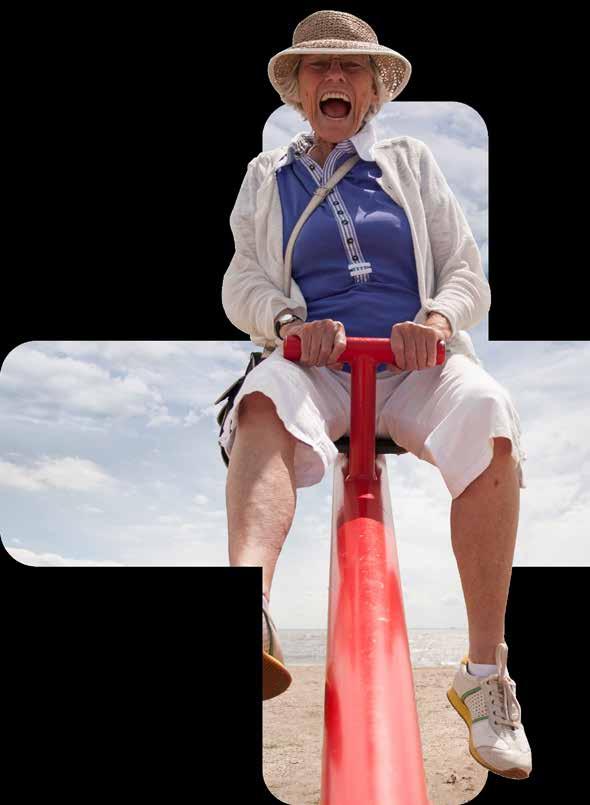

SEASONAL EATING HAS BECOME A POPULAR TALKING POINT IN RECENT YEARS DUE TO ITS FOCUS ON SUSTAINABLE LIVING AND THE WAY IT REDUCES PRESSURE ON FARMERS TO PRODUCE FRUITS AND VEGETABLES OFF SEASON. THERE ARE ALSO NUMEROUS NUTRITIONAL BENEFITS TO EATING SEASONALLY AND THE MONEY YOU’LL SAVE ON YOUR GROCERY BILL IS DEFINITELY WORTH CONSIDERING. SO, WHAT’S ALL THE FUSS ABOUT? WHAT DOES SEASONAL EATING ACTUALLY MEAN AND HOW CAN THIS SHIFT IN MINDSET AND LIFESTYLE WORK FOR YOU?
According to the ancient Indian practice of ayurveda, eating seasonally is referred to as ritucharya.1 In ayurvedic philosophy, each season has its own unique properties and aligning your diet to meet these different energies is the key to maintaining health and preventing disease. We can apply parts of this unique philosophy to our own lifestyle by choosing to eat foods that
keep our digestive system balanced and our immune system functioning at full strength. Food that is harvested when it’s fresh and fully ripened contains powerful antioxidants and contains more nutrients than fruit and vegetables that have further to travel.2 A Japanese study found that spinach harvested in the Summer (its natural season) contained three times more vitamin C than spinach harvested in Winter.
With advances in food science and agricultural modifications increasing demand for certain fruits and vegetables to be grown all year round, it can be easy to fall into the trap of eating your favourite produce. But venturing outside your comfort zone and eating fresh produce which offers new flavours and textures could offer you important vitamins and minerals which your current diet might be lacking. Check out seasonalfoodguide.org to learn what fruits and vegetables are in season in your area.
Seasonal eating is not only good for you – it’s good for the planet. Eating seasonally drastically reduces the storage and transportation costs of keeping food fresh for longer. Research into the impact on the environment of seasonal eating is referred to as life cycle assessments (LCAs). This method analyses all stages of the supply chain: everything from growing, harvesting, and transporting food to its consumption. Many studies focus on measuring the carbon footprint through greenhouse gas emissions. However, this is only a small part of the impact which food production has on the environment. Other factors like water footprint, pollution from fertilisers, and land use are worth considering. It’s also a good idea to reduce plastic waste by buying your fruit and vegetables in small quantities and avoiding pre-packaged food. To take your commitment to seasonal eating to the next level, try growing your own herbs or planting a few self-pollinating fruit trees in your garden.
Autumn: March – May
Apple, blackberries, lemon, custard apple, banana, cabbage, potato, parsnip, basil, chervil, thyme
Winter: June – August
Rhubarb, quince, cumquat, kale, carrot, capsicum, swede, spinach, parsley, rosemary, oregano
Spring: September – November
Blueberries, mango, cherry, cantaloupe, radish, sweet potato, tomato, lemongrass, mint, ginger
Summer: December – February
Apricot, honeydew, peach, raspberries, beetroot, lettuce, okra, capsicum
1Ritucharya: https://www.yogapedia.com/definition/10244/ritucharya
2Benefits of eating seasonally: http://drkarenwallace.com/blog-drkaren-naturopathicdartmouth/2017/10/25/benefits-of-eating-seasonally
3Seasonal produce guide: https://sustainabletable.org.au/all-things-ethical-eating/ seasonal-produce-guide/
Keeping Skin Healthy,

A Restorative Moisturiser to Maintain Skin Health.
CREAM MOISTURISER
A Rich, Hydrating Cream to Quench Skin’s Thirst.
SOOTHING MSM MOISTURISER
A Calming Moisturiser for Sensitive or Irritated Skin.

GETTING ENOUGH EXERCISE IN WINTERTIME CAN BE MORE CHALLENGING FOR EVERYONE, EVEN THOSE WHO STAY ACTIVE THE REST OF THE YEAR. BUT WHETHER YOU’RE INTO SPORTS OR YOU’RE SOMEONE WHO KNOWS THEY SHOULD EXERCISE MORE, IT’S ESSENTIAL TO KEEP MOVING THROUGHOUT THE COLDER PERIODS.
Regular physical exercise is good for both the body and the mind. Getting the heart pumping, and working up a bit of a sweat, can reduce our risks of coronary heart disease, stroke, type 2 diabetes and even depression. The hormones released during exercise can also help combat depression.
There are all sorts of additional benefits, too – like feeling more connected to the world around you, making friends, taking photos along the way, and feeling a sense of pride in your achievements.
If you’re exercising outside, the cold and dark could easily put you off. Our bodies lose heat through extremities which aren’t usually clothed, like our hands and head, so consider gloves and a warm hat. You might also need a light waterproof jacket, or at least have one with you. A head torch could be useful to brighten your path.
If you plan to exercise in the morning, whether indoors or out, set an alarm – and turn a light on immediately to avoid hitting ‘snooze’! Lay out your clothes, shoes and anything else you’ll need in advance, so you’re not stumbling around looking for something to wear. Get out a water bottle to be filled just before you start your activity, and you could even sort a music playlist to get your rhythm going.
Exercise needs energy, and energy needs oxygen, so be sure to warm up first. This will get plenty of oxygen to your muscles and make your exercise more effective. Doing stretches on the spot probably isn’t all that effective: you’re better off with more movement. Try several minutes of brisk walking, jogging in place, or arm swings, lunges, and squats.
Knowing you’ve arranged to meet someone can help get you up and out – even when you just don’t feel like it. It also makes exercise more fun and helps the time to pass more quickly. If you join a sports club, make sure it matches your skill level, otherwise it will only demotivate you! If you’re not that active already, you could start with a simple walking group, or go for a bike ride with a friend.
If you can’t get outside for exercise, perhaps because of the weather or a lack of time on a particular day, always have an alternative in mind. You could turn to an exercise video (there are plenty online), jog up and down the stairs, get out a skipping rope or weights, or do some vigorous housework. This exercise should last at least 30 minutes and be strenuous enough to get your heart pumping.
If it’s dark, wear a head torch and/or reflective clothing. Perhaps go with someone – or at least, let someone know where you’re going. Always take your phone with you. If walking or running, stick to well-lit routes where there will be other people around. And watch out for icy or slippery surfaces, because an injury will set you back and stop you exercising for a while.
Setting goals, and planning little rewards when you achieve milestones along the way, can help you stay active. Your goals should be realistic and matched to your age and abilities, and they should push you just enough to be of benefit – but not so much as to be potentially harmful.

HAVING A STROKE CAN BE DEADLY. THANKFULLY, 80% OF THEM ARE PREVENTABLE, AND A WIDE RANGE OF TREATMENTS AND THERAPIES CAN IMPROVE THE QUALITY OF LIFE AFTERWARDS. HERE’S A GUIDE TO THE KEY FACTS ABOUT STROKE.
Our brains depend on a healthy and uninterrupted supply of blood. A stroke occurs either when a vessel carrying blood to the brain suddenly gets blocked by a clot, or when a blood vessel bursts and starts to bleed into the brain.
When either of these happens, parts of the brain die off. Around two million brain cells per minute can be drastically affected as a result of a stroke – that’s why it’s so important to act fast.1
There are also mini-strokes called transient ischemic attacks, or TIAs. These are temporary blockages of blood flow to the brain: temporary because the clot usually dissolves on its own, or gets dislodged. The symptoms don’t last long (usually under five minutes) and rarely cause permanent damage. However, they’re a vital warning sign that a full-blown stroke may be waiting to happen.
The effects of stroke
Stroke can lead to a wide range of possible outcomes:
• Paralysis of parts of the body which are usually controlled by the area of the brain where the stroke happened
• Aphasia, which means difficulty speaking or loss of speech
• Problems with swallowing
• Loss of vision
• Cognitive impairment (difficulty with thinking)
• Death.
Stroke likelihood
Around the world, one in four people will have a stroke in their lifetime.1 Our stroke risk increases as we age; however, in 2020, a quarter of all first-time strokes in Australia happened to people aged 54 or under.1
Fortunately, Australia is low on the list of world rankings for deaths as a result of stroke. In 2020, we were 179th out of a total of 183 countries, and rates of stroke in Australia continue to decrease.2
We can put this down to lower rates of smoking and more people using medication to lower their blood pressure. We also have better ways to prevent blood clots and greater access to hospital stroke units.
Despite this, stroke is one of the five leading causes of death in Australia, with around 23 people dying of stroke every day in 2021.2 It kills more women than breast cancer and more men than prostate cancer.1 We should all take responsibility for helping to decrease our own personal stroke risk – after all, over 80% of strokes could have been prevented.1
Stroke is one of the five leading causes of death in Australia.
Stroke terms
• Ischaemic stroke: This happens when a clot or other blockage forms in a blood vessel, cutting off the blood supply to the brain. It’s a thrombotic stroke when it occurs in the brain, and an embolic stroke when a clot forms elsewhere (usually the heart) and then travels to block a blood vessel which supplies the brain.
• Haemorrhagic stroke: This happens when a blood vessel ruptures and bleeds. These can be difficult to treat because they are often hard to reach.
• Transient ischaemic attack (TIA): A mini-stroke that usually doesn’t last long.
• Cryptogenic stroke: This is when the cause of a stroke can’t be found, even after lots of tests.
• Silent stroke: Sometimes, evidence of prior strokes shows up as scar tissue in brain scans, even if the patient never knew at the time.
Symptoms of stroke
The faster someone gets help, the better their chances of survival and recovery. The Stroke Foundation says to remember the ‘FAST’ signs of stroke:
• Face – has the face or mouth drooped?
• Arms – can both arms be raised?
• Speech – is it slurred or confused? Can the person understand you?
• Time – is critical! Call 000 if you see any of the above signs in yourself or another person.
A person suffering a stroke may also have weakness or numbness in one or both sides of their body. They might feel dizzy or unbalanced and may have fallen. They could have loss of vision in one or both eyes, a sudden severe headache, and/or difficulty swallowing. They may be drowsy or even pass out.
Act fast
While waiting for the ambulance,
• The person should lie on their side with their head slightly raised
• They shouldn’t have anything to eat or drink
• Any tight clothing should be loosened if it might cause breathing difficulties
• If there is obvious weakness in a limb, it should be supported and not manhandled
• If there is no pulse or they aren’t breathing, start CPR immediately. You may need advice on how to do this over the phone from the ambulance service.
The first thing to do is find out what happened. The hospital will carry out tests which could include a CT, MRI or ultrasound scan, and an angiogram (an x-ray of blood vessels), to find the problem and assess your blood flow, along with blood tests.
Depending on the type of stroke, the following may be offered as treatments:
• Medicines to dissolve the blood clot and restore blood flow to the brain
• An ‘endovascular thrombectomy’ – where a thin tube is inserted into your blood vessel to find and remove the blockage
• Blood-thinning medication such as aspirin
• Medication to manage your blood pressure
• Brain surgery, for example, to reduce swelling or repair a blood vessel (although this is less common)
In the longer term, stroke patients may need rehabilitation to help improve their speech, swallowing, mobility and any other problems. This might involve physiotherapy, speech therapy, occupational therapy, and even psychological support.
The best things you can do to decrease your risk of a stroke are:
• Manage your blood pressure and cholesterol
• Manage your type 2 diabetes, if you have it
• Stay active and do exercise
• Eat healthily
• Control your weight
• Stop smoking
• Cut down on alcohol.
You may not be able to do much about some stroke risks. For example, you’re at a higher risk if you:
• Have previously had a stroke or have a family history of it
• Are older or male
• Have had an infection, illness, or injury which makes clots more likely
• Are pregnant (for some, this can lead to raised blood pressure)
• Are taking oral contraception or hormone replacement therapy (HRT).
Strokes are a serious threat to our wellbeing, and the risks should be taken seriously. The good news is that four out of every five strokes can be prevented by following our tips to prevent stroke. Even if you’re unfortunate enough to have a stroke, survival rates are continually on the rise and there have been great strides forward in improving quality of life after stroke.
1Top 10 facts about stroke: https://strokefoundation.org.au/about-stroke/learn/factsand-figures
2Stroke: https://www.aihw.gov.au/reports/heart-stroke-vascular-diseases/hsvd-facts/ contents/summary-of-coronary-heart-disease-and-stroke/stroke




RUN CLUBS ARE AN INCREASINGLY POPULAR WAY TO IMPROVE HEALTH, FITNESS AND WELLBEING. DURING WINTER, WHEN IT CAN BE HARD TO FEEL AS MOTIVATED, JOINING A RUN CLUB CAN BE A GREAT WAY TO STAY SOCIAL, ACTIVE AND MAINTAIN A REGULAR EXERCISE ROUTINE.
There are lots of reasons why you might be willing to turn out and go running with a club this Winter, even if it’s dark and shivery outside.
• Community – run clubs can offer a great sense of community. For example, if you work from home a lot or are normally at home with small children, it can be an important way to get out and meet people.
• Health – running can maintain strong bones and joints while strengthening your muscles. Mentally, running can help you fight depression and cope with stress, boost your mood, and improve your memory and concentration.
• Safety – running as part of a group can also offer real safety advantages. Women usually feel safer when they’re not on their own, and with a group there will always be someone to help if you fall or injure yourself when running.
• Development – other runners and coaches can offer great tips, advice and encouragement, and clubs often offer discounts at sports shops.
• Cost – running really doesn’t cost that much. You need a decent pair of shoes, some warm clothing, and perhaps a club fee.
• Is it easy to get to? Location and parking are important: it’s too easy to get discouraged in Winter. And are there toilets on the routes?
• Is there a cost? Either to join, per run, or for training, for example.
• Are you looking for a special interest group? There are clubs for men, women, and mothers, as well as for seniors or children. There are clubs for particular professions, LGBTQ+ groups, clubs for survivors of injury or illness, and many more.
• When do they meet? You might be looking for early-morning, evening, weekend, or even midnight runs.
• Are they right for you? Many clubs welcome everyone, from beginner to elite, but it’s best to check first.
• Is it fun? Check whether they offer innovative and fun ways to run, as well as social events.
• Are there options? Check if the club offers a range of running programs, such as race-walking, distance running, road-running, sprinting, athletics, cross-country and triathlon.
• Are there competitions? You might be competitive, or perhaps you’re ambitious, or you just want to track your progress.
If you’re shy, look for someone who also seems new or nervous, and say hello. Also, find someone who’s in charge and check that you have what’s needed, and what’s expected of you.
The social side is important, so start and join in with conversations. And while headphones or earbuds can be great for solo running, they can exclude you from participating in groups.
Finally, accept that the first group you try may not be for you. Clubs can often be cliquey, or may not be inclusive enough for your tastes. They may be too amateur, or look down on beginners. If it doesn’t feel right, just find a different group.
There’s no reason why you can’t run in the cold, dark and wet, but be prepared. Make sure you dress appropriately (wear or carry layers), and your shoes will need a non-slip sole you can rely on.
Think about a head-torch to help light your way and make sure you’re visible to drivers. Don’t allow yourself to hit ‘snooze’ if it’s a morning run.
Most of all, ensure that you warm up properly to be a more effective runner and reduce your risk of injury.

IT’S VITAL TO UNDERSTAND THE CAUSES AND TREATMENTS OF DIABETES, BECAUSE SO MANY OF US ARE AT RISK. BUT IT CAN BE CONFUSING: WHAT ARE THE DIFFERENT TYPES? IS IT ABOUT TOO MUCH OR TOO LITTLE SUGAR? HOW IS IT TREATED… AND CAN YOU CURE IT? HERE’S OUR GUIDE.
One and a half million Australians are living with diabetes, and an additional 400,000 are at high risk of developing it. Every year, 120,000 of us are told we have diabetes.1 And this is bad news, because it’s a serious and long-term condition. Diabetes occurs when your pancreas can’t produce enough insulin (a hormone which regulates how much sugar is in your blood) or when your body can’t make good use of the insulin you produce. In both cases, this means your blood sugar can rise dangerously high. You can also be at risk of it falling dangerously low.
“Diabetes is a major public health problem that is approaching epidemic proportions globally.”
International Journal of Health Sciences2
The cause of type 1 diabetes is unknown. What we do know is that it’s an autoimmune condition; it can’t be prevented and there’s no cure; and it mostly affects higher-income countries. It isn’t linked to weight or exercise. Although it’s often associated with the young, in fact around half of all people diagnosed with it are over the age of 30.3
Living with type 1 diabetes requires very careful management. If you are diagnosed, you may need to test your blood glucose levels multiple times a day, and take insulin every day of your life.3
This type is on the rise, and many scientists are asking whether it may be “the biggest epidemic of the twenty-first century”.3 Type 2 diabetes usually develops in adults over the age of 45 years but is increasingly occurring in children, adolescents and young adults. There are many complex causes of type 2 diabetes, but it's often triggered by excess fat inside the liver and pancreas.
Research has shown that it’s possible to prevent up to 58% of type 2 diabetes cases, but this usually means that individuals need to make major lifestyle changes – and they need to know about those changes, and be willing to do them.3 For example, being overweight doesn’t cause type 2 diabetes, but it can be a major risk factor. To help prevent type 2 diabetes, it’s important to maintain a healthy body weight; do at least 30 minutes of moderate exercise every day; eat healthily (avoiding sugar and saturated fats); and not smoke tobacco.4
Around half of all people with type 2 diabetes will need to start taking insulin within 10 years of being diagnosed. This is because the pancreas produces less insulin as we get older.3
Gestational diabetes
This type of diabetes occurs during pregnancy, and leads to high blood sugar levels because the mother’s body can’t produce enough insulin for her additional needs. It must be managed well, because it can cause problems for both mother and baby, but it usually goes away after the birth. It can start at any point in the 40 weeks, but is less common in the first three months.
Symptoms of diabetes
If you have one or more of the following unexplained symptoms, it would be worth having a chat with a medical professional:
• Feeling very thirsty, very often
• Needing to wee often
• Blurry eyesight
• Feeling very tired most of the time
• Losing weight when you didn’t mean to.
Risks of diabetes
• Blood vessel damage: Over time, diabetes can cause damage in the heart, eyes, kidneys and nerves, and this damage can have serious consequences.
• Sight loss: There is a risk of permanent loss of vision because of damaged blood vessels in the eyes.
• Serious foot problems: The combination of nerve damage and poor blood flow can lead to ulcers in the feet, which can cause severe damage to tissue and bone. If an ulcer isn’t treated or won’t heal, it can result in the amputation of one or more toes, the foot, or even part of the leg.
• Diabetic ketoacidosis: This can happen when a serious lack of insulin in your blood causes your blood sugar to rise so high that harmful ketones build up. Usually, people with type 1 diabetes are at most risk, but it can also happen if you have type 2 diabetes and you need to take insulin. This is a very serious condition; it comes on quickly (usually within 24 hours) and needs urgent treatment in hospital.
• Hyperglycaemia: This is when your blood sugar gets too high and insulin levels aren’t controlled. It can also happen if you eat too many carbohydrates (which break down into sugars); if you are sick or have an infection; if you are stressed; or if you aren’t getting enough physical activity.
• Hypoglycaemia: This is the opposite of hyperglycaemia, when blood sugar levels drop too low. You may be at risk if you take insulin or if you’re taking certain types of medication for your diabetes. It can be caused by missing a meal, not eating enough carbohydrates for a given dose of insulin, physical exertion, and alcohol. Without rapid treatment, it can lead to loss of consciousness or seizures. If your blood sugar drops too low and symptoms develop, it’s vital to have some quick-acting glucose, such as a glass of non-diet soft drink, fruit juice, glucose tablets, small lollies.
In addition, people with diabetes are at greater risk of heart attack, stroke and kidney failure.
People with type 1 diabetes must have daily insulin injections. They can test their blood sugar and administer these injections themselves.
If you have type 2 diabetes, you’ll need medicine to manage your blood sugar. This might mean insulin, but there are also other medications. Additionally, you may need medication to lower your blood pressure as well as statins to reduce the risk of complications. Everyone with any type of diabetes must pay attention to a healthy, well-balanced diet, exercise sensibly, and maintain a healthy weight.
There’s been a lot of media coverage about people ‘reversing’ their type 2 diabetes. In fact, this is a remission, not a cure, and it’s triggered by deliberate weight loss. It means that the symptoms of diabetes are reduced or disappear. There are significant health and lifestyle benefits, but this should only be done with the support and guidance of your healthcare professional.
To learn more about diabetes, visit your local Blooms The Chemist pharmacy and talk with our friendly Pharmacists. You can also find out more at diabetesaustralia.com.au
“Diabetes
was among the 10 leading causes of death of Australians in 2021, contributing to around 11.2% of all deaths.”
– Australian Institute of Health and Welfare 5
1Diabetes Australia: https://www.diabetesaustralia.com.au
2Is diabetes becoming the biggest epidemic of the twenty-first century?: https://www. ncbi.nlm.nih.gov/pmc/articles/PMC3068646
3Myths and facts: https://www.diabetesaustralia.com.au/about-diabetes/myths-facts
4Diabetes: https://www.who.int/news-room/fact-sheets/detail/diabetes
5Diabetes deaths: https://www.aihw.gov.au/reports/diabetes/diabetes/contents/impactof-diabetes/diabetes-deaths






PERHAPS YOU’RE WONDERING WHETHER TAKING A PROBIOTIC OR PREBIOTIC COULD HELP YOUR DIGESTION, BUT AREN’T SURE OF THE DIFFERENCE BETWEEN THEM – OR WHAT YOU NEED TO CONSIDER. HERE’S OUR GUIDE TO ADDING THEM TO YOUR DIET, AND WHY SOME PEOPLE MIGHT NEED TO THINK TWICE.
We all have a community of about 200 types of bacteria, viruses, and fungi living in our stomach and intestines (our gut).1 This is called our ‘gut microbiome’, and together they total over 100 trillion cells.2 Although this might sound off-putting, the vast majority are very beneficial or even essential for a healthy body and mind.
Research shows that having a wide variety of microorganisms in your gut can help to reduce the risk of developing conditions like:
• diabetes
• inflammatory bowel disease (IBD)
• psoriatic arthritis.
More and more studies are being done to find out how our gut health is connected to our overall physical and mental health. For example, it is now known that poor gut health is linked to:1
• Mental health disorders – such as anxiety, stress, or depression. This is because your gut produces neurotransmitters, such as serotonin and dopamine, which help to improve your mood.
• Autoimmune diseases – where your body attacks healthy cells by mistake
• Endocrine conditions – which means problems with your hormones; for example, insulin
• Gastrointestinal disorders – anything from constipation to Crohn's disease and ulcerative colitis
• Cardiovascular disease — affecting your heart and blood vessels
• Cancer Symptoms of poor gut health
Poor digestion can be an obvious sign of a gut health problem. For example, you might have heartburn, constipation, or diarrhoea. You might also feel gassy and bloated.
Other symptoms of poor gut health include always feeling exhausted, and finding that you don’t sleep for long enough or keep waking in the night. You might also have irritation of your skin – like spots or itchy rashes.
Focussing on keeping your gut healthy can help you to feel better all over.
You might have heard about nutritional support like probiotics and prebiotics, or you may even have tried experimenting with them. However, it can be confusing to understand the difference between them:
• Probiotics: These are special supplements which contain living bacteria, and they are designed to manage the number and range of ‘good’ bacteria in your gut. This usually means bacteria in the Lactobacillus and Bifidobacterium families. They help you to digest your food, fight illnesses, and produce vitamins such as vitamin K. Vitamin K can help wounds heal and may be important for bone and joint health.
• Prebiotics: These provide food for the good bacteria in your gut. When you feed these bacteria, they become healthier and, in turn, can help to keep you healthier. Prebiotics are a kind of non-digestible fibre, in the carbohydrate food group – and although you can get them as a supplement, you can just as easily get them from eating the right foods.
• Synbiotics: These contain both prebiotics and probiotics. Some occur naturally in foods, such as sauerkraut, types of cheese and yoghurt, and kefir (a fermented milk drink). However, most people looking for synbiotics will take a bought supplement. Although it’s not necessary to take a prebiotic for probiotics to work, they might help to make your probiotic more effective. On their own, prebiotics are usually good for you as part of a well-balanced diet, but typically won’t have the desired effect on your gut microbiome unless you also take a probiotic.
• Dietary sources: Fermented foods contain natural probiotics and are growing in popularity. Look for foods made from fermented beans, dairy products, and vegetables. Try eating more sauerkraut and kimchi (both made from fermented cabbage), yoghurt, pickles, and soybean products such as natto, tempeh and miso. There are drinks, too: you may find a benefit from drinking kombucha, a fermented tea drink, or kefir, which is made from fermented milk.
• Supplements: You can take probiotic supplements as a powder or liquid, which will probably need to be refrigerated. Tablets are available which don’t need refrigeration.
• Dietary sources: Most people should eat a very broad range of fruit, vegetables, legumes (like lentils and beans), and whole grains (such as brown bread and rice, as well as quinoa). However, if you suspect your gut health could be improved, you should add even more of these into your daily meals. Vegetables to focus on include leeks, asparagus, potatoes, onions, and garlic, while helpful fruits include bananas and kiwifruit.
• Supplements: You can buy prebiotic supplements as powders and tablets.
Many people can benefit from taking a probiotic. However, it’s always best to check first with your GP or a Pharmacist, just in case they interfere with any condition you already have.
For most people, taking a probiotic unnecessarily won’t cause any problems. However, some people need to be cautious. If you have a compromised immune system, for example, or you’re taking immunosuppressant drugs (such as chemotherapy in cancer treatment), you shouldn’t take probiotics. Nor should anyone with a critical illness. If you are lactose-intolerant, ensure you choose a dairy-free probiotic. People who have a yeast overgrowth condition, such as thrush, will need to choose one which doesn’t contain Candida yeast.
If you decide to try a probiotic supplement, you might find that your digestion is disrupted in the early days. Commons signs include stomach gas, constipation or loose bowels, and even loss of appetite. These should improve in time, and you should drink plenty of water throughout the programme.
However, some people can have a serious allergic reaction to probiotics. If you have nasty stomach pain, or you develop hives (itchy, raised bumps or blisters on your skin), stop taking the probiotics right away and talk to your doctor.
Certain bowel conditions may get worse with prebiotics. For example, irritable bowel syndrome (IBS) could flare up with a prebiotic – even though a probiotic may actually help you.3 And if you know that you have small intestinal bacterial overgrowth (SIBO), or that you have problems absorbing certain foods, you should avoid adding prebiotics to your diet.
A lot of research is being done into prebiotics and probiotics. While they may support your overall health, it’s important not to rush into taking them. Talk to your local Blooms The Chemist Pharmacist if you’re wondering whether a probiotic or prebiotic could help, and they'll guide you in choosing the right one for you.
1What is the gut microbiome and why is it important?: https://www.healthline.com/ health/gut-health#gut-microbiome
2Role of the gut microbiota in health and chronic gastrointestinal disease: https://www. ncbi.nlm.nih.gov/pmc/articles/PMC3667473/#:~:text=Our%20gut%20harbours%20 a%20complex,inflammatory%20bowel%20disease%20and%20obesity
3Before trying probiotics, beware of these potential side effects: https://www.mens health.com/nutrition/a42433382/probiotics-side-effects/
Get to know the team at Blooms The Chemist Forestville, NSW.

Kim
One health tip I can give is to check your sleep health! Certain health conditions, such as diabetes or high blood pressure, can put you at risk of sleep apnoea – which can have a significant impact on other aspects of your health.
The best part about Forestville is a nice community feel, a friendly environment where staff help and support each other.
I love working with the public, especially the elderly. Getting to help people in my role puts a smile on my face!
Forestville is a great location, close to schools and transport. Everyone knows each other in the community, lots of families have lived here for generations and know the history and new families moving in as it’s a great area for families. I love it when customers come in and they know each other and have a catch up in the store.

bloomsthechemist.com.au